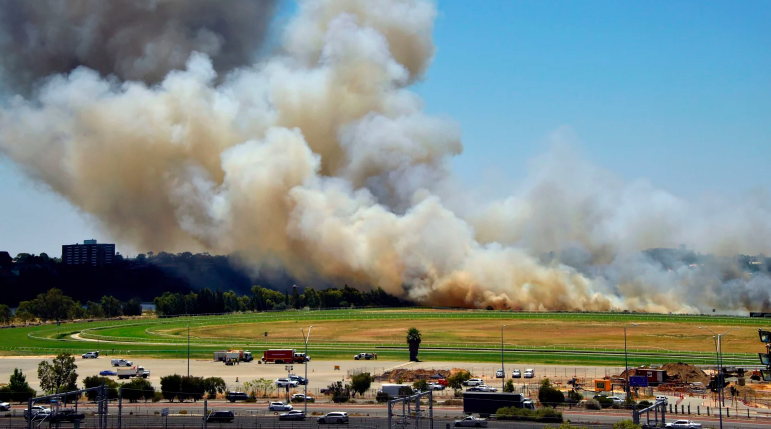The more one gets to hear about the developments in the world, in the wake of pushing growth, forwarding and promoting economic agendas, and making a scope to heighten productivity, the more one familiarizes the self with climate change. Climate change is, inarguably, the dominant discourse our time, and without a doubt, more than some figurative fire-breathing devil. It cannot be ignored as the world is, by every tick of the clock, coming ever so closer than ever before with the negatives of subjecting the climate to atrocities.
We have ignored the very spaces we have come to inhabit and now, there is panic!
Climate Change has already given much of the developed world’s economies a headache, for the simple reason that the general feeling is that not an awful lot is being done to address the situation that can no longer be repressed. Information, in the form of news, feeds, scrolls and ‘in-depth’ coverages highlighted by expert opinion all point to the common albeit grave narrative: someone’s got to do something to fix the woes!
But is the world truly listening? In fact, what is Australia doing in its bid to eschew from contributing to the evil of climate change? Here’s a number that might warrant a reaction. From the period of 1850 to 2002, Australia was singularly responsible for 1.1% of all CO2 emissions on the planet.
What do we infer from this rather banal-looking observation? Well, the fact that Australia’s hand in contributing to the CO2 emissions was three-times the share given its own population, at this time.
However, back in Down Under, the general consensus among the locals was always that Australia shouldn’t bother too much for the simple reason that its contribution to climate change wasn’t too seizable or worrisome vis-a-vis other nations.
Fact!
However, a professor at the University of Queensland, Matt McDonald noted that the problem is far too serious than generally presumed, given the somewhat uncanny co-relation between the CO2 emissions and the total population.
That the overall share to global climate change- by virtue carbon footprint- was only 1.3 percent surely seems not too high a figure, but the very fact that the total population of the continent is no more than 0.3% of the world’s share makes the former figure a telling one.
Furthermore, the Associate Professor of International Relations also highlighted the need for Australia to take its emissions seriously for if rich nations such as the “Land Down Under” didn’t lead by an example, then what motivation would the developing parts of the world have in cutting down their share of carbon emissions.
Makes sense?
But specifically speaking of Australia, there’s been no dearth in ecological dysfunctionalities, so to speak.
The Guardian had earlier this year point out that the carbon emissions have been rising, thanks largely to the LNG industry. According to the latest numbers, Australia is flexing its muscle in overall LNG production and distribution- at a global level- with Qatar, the most prominent figure in the realm.
As of August 2019, the national emissions increased by 3.1m tonnes in the year to March to reach 538.9m tonnes, a 0.6% jump on the previous year, as quoted by The Guardian.
Of late, Australia’s struggle with climate change has been a constant. It has been a familiar subject that has drawn observations and piqued the interest of researchers and environmentalists for a while.
But let us, for a second, rewind the clocks back to half a decade. In fact, in 2013, the Commonwealth Scientific and Industrial Research Organization, better known as the CSIRO had submitted that the continent had already begun getting hotter. The finding, from that point on, begun to draw several reactions from the key stakeholders, strengthening the scope of taking remedial action in the course of the future, against the ticking time bomb- for how else would one put it- that is climate change.

Fast forward to 2019, and we begin to understand Australia’s struggle with climate change, a phenomenon that didn’t find any reprieve whatsoever, given the relentless scourge of an unfriendly ecology made worse by cyclones, floods, and as seen in the more recent times, then bushfires.
But in order to understand the true severity of the destruction stoked by climate change, one has to make space to understand the economic malaise and damage brought on by climate change in the vibrant continent.
Experts suggest that where the past few years are concerned, then among the big creations of climate change has been the period of extended heat, a factor that may likely continue in the coming period.
Moreover, bushfires have taken the states of New South Wales and Queensland, principal contributors to the national economy, in a serious grip.
The Meteorological department has already suggested that the period from January to March will already be warmer than before.
To quote reactions from the ground, then the New South Wales Rural Fire Service raised concerns, stating, “fires and smokes will continue!”
Additionally, the bushfires that Queensland and New South Wales endured amounted to emitting of 250 million tons of carbon into the atmosphere. The reason to up meaningful action to curb climate change isn’t only necessary because of moral responsibility but also evidently urgent for the continent’s own good.
Apart from the fact that one of the most diverse landscapes in the world has lost already a sizeable chunk of its forests- around 6.7 million acres of land to bushfires- the damage bill for the continent in lines with the damage wrecked by ecological disasters in the past decade measures around $37 billion Australian dollars, that’s nearly $27 million USD.
The time to act is now and the need hasn’t been more urgent!


